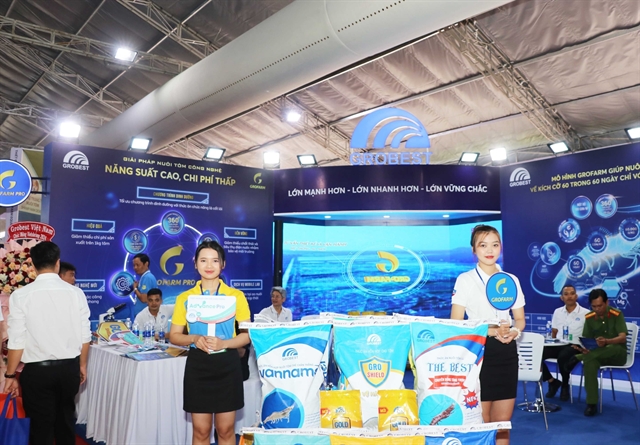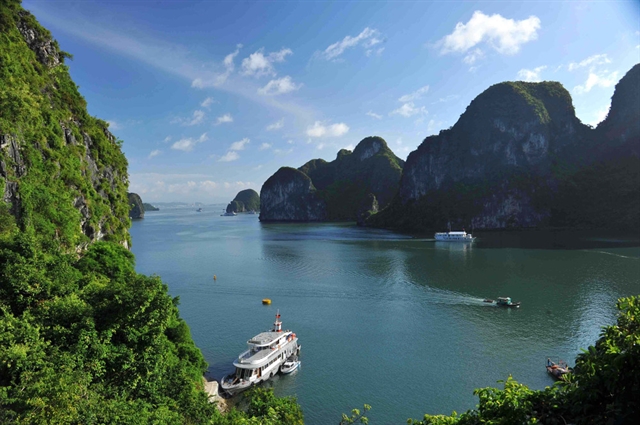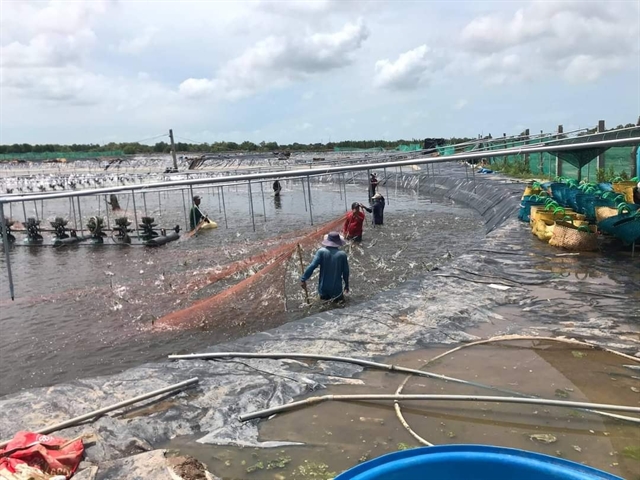 Economy
Economy

 |
| Harvesting shrimps in the hi-tech aquaculture farm in Bạc Liêu Province. VNS Photo |
BẠC LIÊU – Establishing an ecosystem for the shrimp industry requires businesses, co-operatives, farmers, and a supply chain connection to a linked system covering seed production, commercial farming, feed and processing.
That was the recommendation from the deputy Minister of Agriculture and Rural Development Phùng Đức Tiến during a working visit to southern Bạc Liêu Province to assess shrimp industry development for 2025.
The aquaculture sector in Bạc Liêu has made remarkable progress in recent years thanks to the widespread application of advanced farming techniques by companies, businesses, and shrimp farmers, all of which help to minimise risks in production.
However, aquaculture has been affected by extreme weather conditions, unpredictable disease outbreaks, high feed costs, inconsistent seed quality, unstable selling prices and the recurring issue of oversupply leading to price drops, causing concerns for shrimp farmers.
There is some hope since right now some seafood products are experiencing price increases, particularly raw shrimp, a positive signal for shrimp farmers to continue production and expand farming areas in 2025.
Bạc Liêu is a leading locality in the Cửu Long Delta region and one of the top provinces in Việt Nam in terms of high-quality shrimp breed production, accounting for over 50 per cent of the region’s supply and approximately 22 per cent of the country’s total.
The province has 360 shrimp breed production and nursery facilities, including 220 units with a designed capacity of 40 billion postlarvae per year, 140 nursery facilities and 30 facilities for giant freshwater prawn seed production, with an estimated annual capacity of 1.1 billion postlarvae.
Last year, the province produced 38 billion postlarvae, including 14 billion black tiger shrimp types, 24 billion of white-leg shrimp and 900 million of giant freshwater prawn.
This output is not just expected to meet local shrimp farming needs but also supply other provinces.
The deputy general director of Việt Úc Bạc Liêu JSC, Trình Trung Phi, said that shrimp prices are currently high, which is a relief, making shrimp farming attractive. However, disease outbreaks are increasing, water pollution is worsening and pathogens in water sources remain a significant challenge.
He suggested that farmers reduce stocking densities and apply biosecurity measures to mitigate risks. If a farm cannot meet biosecurity standards, it should refrain from stocking shrimp.
Regarding shrimp breed production, Việt Úc is applying genetic selection technology to produce shrimp with fast growth rates, high disease resistance and with enhanced adaptability to low salinity conditions.
Phi proposed that the Ministry of Agriculture and Rural Development direct specialised agencies to focus on researching new shrimp diseases and developing effective prevention and treatment solutions.
Additionally, restructuring the shrimp industry’s development strategy to better manage disease outbreaks and establishing production chains with policy support for the aquaculture sector is essential, he said.
Developing low-emission shrimp farming models that adapt to climate change, while ensuring high productivity and sustainability, should be looked at more closely, he added.
Strategy for the shrimp industry
Lê Hoàng Minh, director of the Bạc Liêu High-Tech Shrimp Development Agricultural Zone, said that infrastructure development for the zone has been 97 per cent completed in phase two and is expected to be finished soon.
Nine businesses have been selected to invest in the zone across four main areas - shrimp farming technology testing, biological product development, shrimp seed production and shrimp feed research.
Following MARD’s directive calling for the completion and commissioning of the Bạc Liêu High-Tech Shrimp Development Agricultural Zone, the provincial People’s Committee has directed relevant agencies to collaborate with the Management Board of the High-Tech Agricultural Zone to implement the ministry’s recommendations, including investing in testing and inspection equipment and work facilities for the zone.
Additionally, the province will allocate management personnel for the zone, propose investment attraction policies and devise land-use plans to encourage business participation.
The provincial government will also strengthen inspections and accelerate project implementation to ensure completion by 2025.
Deputy Minister Phùng Đức Tiến said that developing a shrimp industry ecosystem requires multiple factors, including zoning shrimp farming areas, improving seed quality, promoting commercial shrimp farming, developing feed mills and establishing processing plants.
Shrimp farming zones must align with environmental regulations, including agricultural and aquaculture environmental protection measures at local and provincial levels.
These zones should have leading enterprises to drive industry growth and collaborate with cooperatives and farmers.
Shrimp seed production must ensure high-quality genetics, fast growth, low mortality rates and high feed efficiency, while all farming areas need to adhere to biosecurity standards.
Raw material production areas must be linked with processing plants, and these plants must be aligned with export market demands. VNS